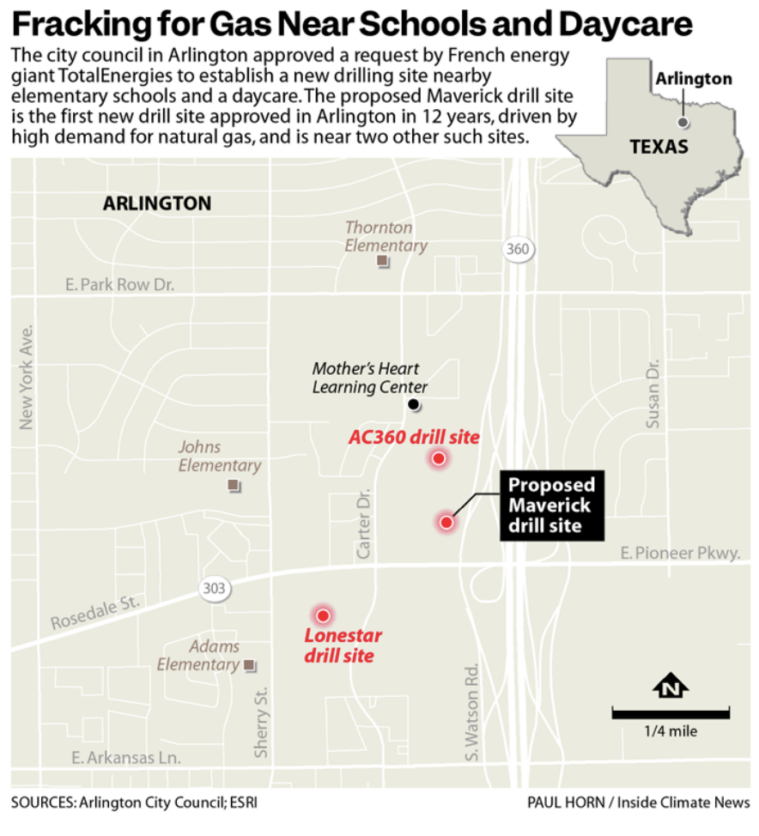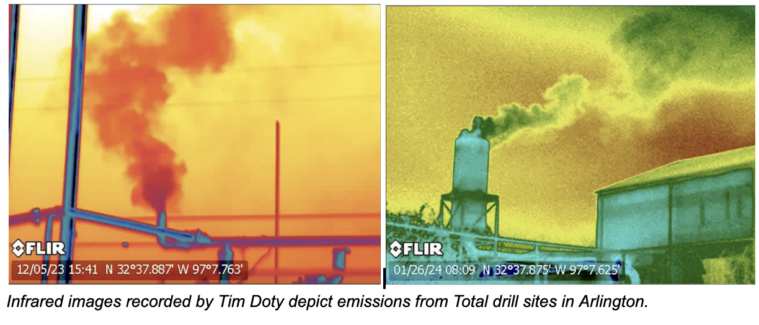Editor’s Note: This article originally appeared at Inside Climate News, a nonprofit, independent news organization that covers climate, energy, and the environment. It is republished with permission. Sign up for their newsletter here.
In the heart of the Dallas-Fort Worth Metroplex, the City Council of Arlington on Tuesday approved plans by French energy giant TotalEnergies to drill 10 new gas wells near a daycare center, residential neighborhoods and elementary schools.
It was the first time in nearly 13 years that Arlington, situated atop the gas-rich Barnett Shale, has approved a new tract of land for fracking, as America’s surging production of oil and gas continues to push record highs.
On Tuesday night, more than 30 residents spoke at City Hall against the proposal, citing concerns over air pollution, public health and childrens’ wellbeing. One person, an economist for the Texas Oil and Gas Association, spoke in favor of the new wells before the eight-member council passed it unanimously.
The new site, named Maverick, is located 910 feet from the nearest residence, 1,060 feet from the daycare center, 2,200 feet from one elementary school and 3,100 feet from another, according to a city report. It sits next to an existing drill site where Total previously tried to add new wells, but faced steep community resistance and two rejections from the council in a saga that drew national attention.

Scores of similar sites already abut residential and commercial properties across Arlington, population 400,000.
“We’ve already seen our staff and our children ill from the effects of drilling,” said Wanda Vincent, owner of Mother’s Heart Learning Center, a daycare adjacent to a Total drill site with four wells and nearby the new Maverick site. “We cannot afford to have another site adding onto the harmful effects from the emissions we are already experiencing.”
A spokesperson for Total, which operates the majority of gas wells and infrastructure in the Barnett Shale, told the City Council that the site would be surrounded by a masonry wall and a tall sound barrier to mitigate pollution, as is the case at its other 50 drill sites in the Arlington area. The spokesperson, Leslie Garvis, said Total would also plant 228 cedar trees around the installation.
She said 17,000 mineral interest owners in Arlington would receive royalties from the horizontal wells drilled deep under their property, including 700 within one mile of the drill site.
“This represented the best location to access these minerals,” she said.
Although new wells have been added to existing Arlington drill sites in recent years, this was the first time since April 2012 that the city approved a new drill site, opening more land for fracking.
In the Barnett Shale, birthplace of the fracking revolution, current production is a fraction of what it was at its peak, almost 15 years ago. But lately, the rising price of natural gas has fueled an uptick in activity, said Dwayne Purvis, founder of Purvis Energy Advisors in Dallas.
“The commodity price has increased significantly in the last couple years,” he said. “That higher commodity price changes the economic returns of drilling.”
Even as prices increase, drillers struggle to grow their footprint in urban areas like Arlington, where oilfield infrastructure is already hemmed in by neighborhoods and shopping centers.
In Tarrant County, which includes Arlington and Fort Worth, almost a million people live within a half mile of an oil and gas well, according to data from FracTracker Alliance and Earthworks, more than any other county in Texas. More than 30,000 Arlington children go to public schools within half a mile of wells, and up to 7,600 infants and young children attend private daycares within that radius, according to a 2021 analysis by the investigative radio show Reveal.
“The majority of places inside Arlington where a well could be located have already been drilled. There aren’t many locations left,” Purvis said. “Whether or not those are drilled will depend on whether or not wells are expected to make money.”
Previously, Total sought to add three new wells at its existing drill site called AC360, next to Mother’s Heart daycare. It faced steep opposition from local communities and was narrowly rejected twice by the City Council, in 2020 and 2022.
Later, Total applied to license a new drill site adjacent to AC360 at the Maverick tract, which Total has owned since 2008, with plans for 10 new wells.
“What’s happening now is way more egregious than those two earlier drilling plans,” said Ranjana Bhandari, director of the group Liveable Arlington, who has lived in the city for 32 years. “The preschool is now going to be downwind from not just one but two drill sites, not four but 14 wells.”
Total did not respond to a request for comment sent Tuesday.
Hazardous emissions can come from the gas wells in several ways. First, gases leak during drilling and can burst to the surface when underground pressure pockets are punctured. Then, the process of fracking, when underground shale is fractured with water pressure, requires a fleet of heavy industrial machinery running for weeks on end.
Later, Texas law known as Statewide Rule 32 allows well operators to release raw gas into the air for the days or weeks immediately after the fracking process. The rule also allows operators to release gas with a permit from storage tanks, during well cleaning or for up to 24 hours for shutdown or unloading, according to the Texas Railroad Commission, which regulates oil and gas production.
“There’s emissions that are going to come out of every site,” said Tim Doty, a pollution monitoring contractor who has studied sites in the Barnett Shale for 15 years. “They may have them relatively controlled, but they have permission to emit.”
Doty, a former team leader for the Texas Commission on Environmental Quality’s mobile pollution monitoring unit, conducted a survey of Total sites in Arlington in 2023 for the nonprofit Earthworks, which produced a report with his observations. Doty visited 24 sites every month for six months and used his optical gas imaging camera to watch for emissions.
In that time he recorded more than 80 instances of significant pollution, including exhaust emissions from a power generator and two compressors at Total’s Agape site, 280 feet away from a daycare, and a hydrocarbon leak on a storage tank pressure relief valve at the Cornerstone site, 500 feet from a church and school.

At the Palo Verde site, 1,100 feet from a daycare, Doty recorded “huge hydrocarbon tank emissions from two tanks with open lids” and “high pressure emissions that lofted way distant from sources with residential properties in the background,” according to his report.
At the Bruder site, 320 feet from the nearest home, Doty found active fracking taking place and wrote, “Massive emissions of sand and hydrocarbon lofting far into the airshed. Clouds near site much more brown and tan than rest of clouds displaying affects of airborne particulate and emissions.”
After his report, in 2024, Doty invited each member of Arlington City Council to meet with him about the findings, but none of them responded.
“They downplayed the findings from the study,” he said.
Before Tuesday’s meeting, the City Council received five written comments from residents within a quarter mile of Total’s proposed Maverick drill site opposing the plan.
One comment by a 13-year resident named Veronica Salas said, “The potential noise, air pollution and ground instability is unacceptable. Why locate drilling in a densely populated area when less disruptive alternatives surely exist outside city limits?”
Another comment by a nurse practitioner named Jane Nyairo said, “I urge the city to prioritize the health and safety of its residents.”
The city received one comment in support of the drilling plan from someone who did not live near the site.
“I own the royalties under the parcel. The development is good for the city and the royalty owners,” it said.
At the council meeting on Tuesday, Dean Foreman, chief economist for the Texas Oil and Gas Association, also spoke in favor of the project. He said oil and gas operations in the Arlington area had paid $64 million in taxes to schools during the last fiscal year.
“We strongly support this project,” he said. “You have a long and storied tradition of safe, responsible natural gas development in Arlington.”
Arlington Mayor Jim Ross told the council that a 2015 Texas law limits the authority of municipalities over oil and gas activities, and that rejecting the project could make the city vulnerable to lawsuits.
“The City Council cannot and will not make its decision based on factors that are outside its lawful jurisdiction,” Ross said.
Almost 90 people attended the meeting in opposition to the measure, including the 30 who spoke. They erupted in a boisterous clamour when the council voted unanimously to approve the new drill site.
The post ‘Drill Baby Drill’: Arlington Approves New Site for Fracking Near Daycare and Schools appeared first on The Texas Observer.
